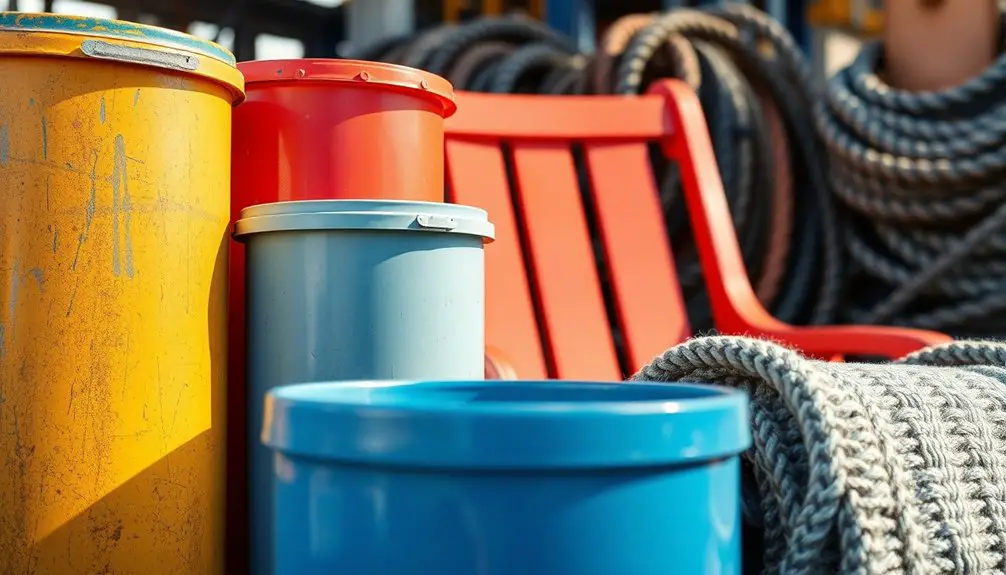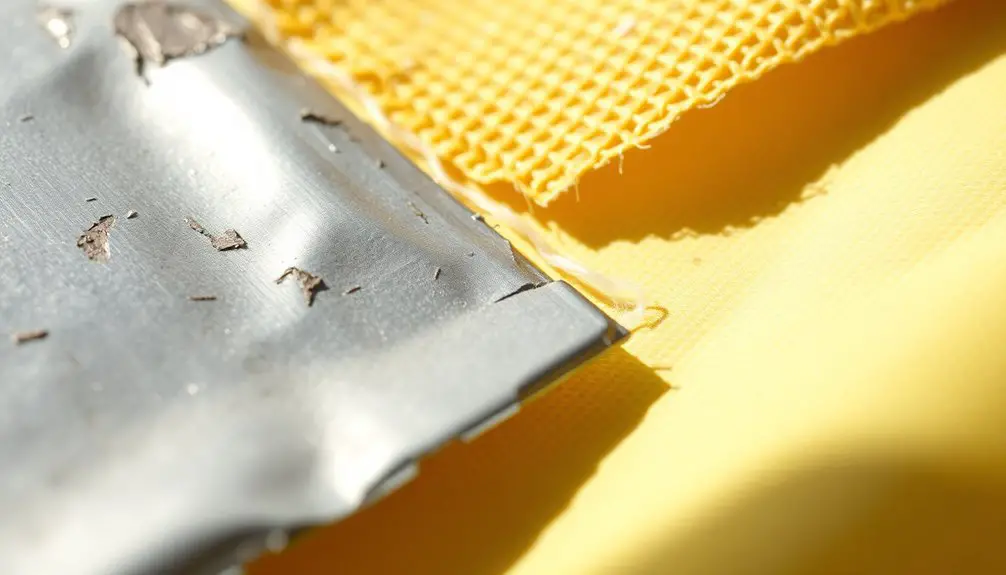Polypropylene's durability is impressive, featuring a tensile strength of around 4,800 psi, which means it can handle heavy loads with ease. Its tough, rigid structure gives it excellent impact resistance, absorbing energy without breaking. Plus, it has low moisture absorption and chemical resistance, enhancing its longevity in various applications, from automotive parts to marine geotextiles that can last up to 200 years. While it's non-biodegradable, making careful waste management important, its unique properties make it a strong choice compared to other materials. You might be interested in finding out more about its applications and environmental impact.
Key Takeaways
- Polypropylene has a tensile strength of approximately 4,800 psi, allowing it to handle heavy loads effectively.
- It exhibits excellent impact resistance, absorbing energy without breaking, enhancing its durability.
- Nonwoven polypropylene geotextiles can last up to 200 years, showcasing its longevity in various applications.
- The material has low moisture absorption (<0.01%), maintaining its mechanical properties over time.
- While durable, polypropylene is non-biodegradable, necessitating proper waste management to mitigate environmental impact.
Understanding Polypropylene's Composition
When you dive into polypropylene's composition, you'll discover it's a thermoplastic polymer made from propylene monomers. This material has a tough and rigid crystalline structure, which contributes to its impressive durability.
As a member of the polyolefin family, polypropylene shares many characteristics with other polymers, but it stands out due to its unique mechanical properties.
Polypropylene can exist in three different chain structures: atactic, isotactic, and syndiotactic. Each structure plays a crucial role in influencing its physical properties and applications. The lightweight nature of polypropylene makes it an attractive choice for various uses, from packaging to automotive parts.
One of the standout features of polypropylene is its chemical resistance, enabling it to withstand various environmental factors without degrading. This property, combined with excellent fatigue resistance, ensures that polypropylene retains its shape and functionality even after repeated bending and flexing.
Its longevity and versatility make it a go-to material in industries where durability is key. Understanding this composition helps you appreciate why polypropylene is among the top three most utilized plastics globally. Notably, polypropylene, like other plastics, has environmental implications, such as contributing to plastic waste pollution and highlighting the need for sustainable alternatives in various industries.
Key Strength Characteristics
Polypropylene boasts impressive strength characteristics that make it a preferred choice across various industries. With a tensile strength of approximately 4,800 psi, it can easily handle heavy loads while maintaining its structural integrity.
This resilience is further enhanced by its excellent impact resistance, allowing the material to absorb energy and deform without breaking, thereby increasing its durability in diverse applications.
In environments where moisture is a concern, polypropylene shines with its remarkably low moisture absorption—less than 0.01% in just 24 hours. This property helps preserve its mechanical properties over time, ensuring consistent performance.
When it comes to longevity, nonwoven polypropylene geotextiles can last up to 200 years under proper conditions, showcasing the material's durability in aggressive environments.
Moreover, incorporating antioxidants during processing plays a crucial role in extending polypropylene's lifespan by preventing oxidation. With an estimated antioxidant lifetime of around 120 years at 25°C, you can count on this material to maintain its strength and functionality over the long haul.
The durability of polypropylene can also be compared to that of PVC pipes, which are known for their high tensile strength and resistance to corrosion, but have limitations in extreme temperatures and pressure conditions.
Longevity in Various Applications

Harnessing its unique properties, polypropylene proves to be remarkably durable across various applications, ensuring longevity even in the toughest conditions.
In marine settings, polypropylene geotextiles can last up to 200 years when properly stabilized and buried, showcasing exceptional durability. These nonwoven geotextiles account for over 80% of waste containment applications, efficiently managing leachate and surface water due to their robustness.
In automotive applications, polypropylene components, such as battery cases and bumpers, benefit from the material's excellent impact resistance and lightweight nature, promoting long-term performance. This durability is further enhanced by antioxidants added during processing, which can extend the material's life to approximately 120 years at 25°C.
Moreover, polypropylene's high resistance to moisture and aggressive chemicals, including nitric and sulfuric acids, significantly contributes to its longevity in harsh environments like landfills.
In contrast, materials like PVC greenhouses have relatively shorter lifespans, requiring regular maintenance to reach their typical lifespan of 20-30 years, showcasing the unique durability of polypropylene in comparison.
Whether in construction, automotive, or waste management, polypropylene's properties ensure that it remains a reliable choice for various applications, proving that its strength and resilience stand the test of time.
Environmental Considerations
While polypropylene's durability makes it a reliable choice for various applications, it also raises significant environmental concerns. One major issue is that polypropylene isn't biodegradable, leading to its accumulation in landfills and oceans. This non-biodegradability contributes to long-term pollution, impacting ecosystems and wildlife.
Although polypropylene is recyclable, the recycling process can diminish its strength, making it less suitable for high-demand uses over time.
Moreover, the production of polypropylene relies heavily on fossil fuels, which contributes to greenhouse gas emissions. This raises sustainability issues, as the environmental footprint of creating polypropylene is substantial.
While antioxidants can be added to enhance its longevity, their effectiveness can wane due to environmental factors like UV exposure and temperature fluctuations.
To address these environmental concerns, proper waste management and recycling initiatives are crucial. Promoting a circular economy for polypropylene products can help mitigate their impact, allowing materials to be reused and recycled effectively. Additionally, only about 9% of plastics are recycled globally, highlighting the need for improved recycling practices to handle polypropylene waste.
Comparing Polypropylene With Other Materials

When evaluating materials for various applications, you'll find that polypropylene stands out in comparison to other commonly used substances. With a tensile strength of approximately 4,800 psi, polypropylene is more durable than many plastics, including polyethylene, which offers around 3,000 psi. This lightweight material also shines in impact resistance, making it a preferred choice over PVC, especially due to its cost-effectiveness.
The longevity of polypropylene geotextiles is impressive, lasting up to 200 years in marine environments, far exceeding alternatives like polyester. Additionally, polypropylene's chemical resistance keeps it unaffected by many aggressive solvents, unlike nylon, which can degrade under similar conditions. This durability ensures that polypropylene maintains its integrity in various applications, including packaging materials.
From an environmental perspective, polypropylene's recyclability enhances its sustainability, especially when compared to non-recyclable materials like polystyrene, which poses greater environmental challenges. Furthermore, its high melting point of 160°C / 320°F allows for safe reuse in certain applications, such as microwaveable dishes, as long as proper care guidelines are followed.
Frequently Asked Questions
What Is a Disadvantage of Polypropylene?
One disadvantage of polypropylene is its poor UV resistance; prolonged sunlight exposure can degrade it. Additionally, its rigid nature makes bonding difficult, and it's not eco-friendly since it's non-biodegradable and derived from fossil fuels.
How Long Will Polypropylene Last?
When you consider polypropylene's lifespan, it can last up to 200 years in optimal conditions. Its resistance to water and chemicals, along with enhancements like antioxidants, ensures it maintains strength and durability over time.
What Is the Life Expectancy of Polypropylene?
The life expectancy of polypropylene can reach up to 200 years in optimal conditions. With proper stabilization and additives, you're looking at impressive durability, especially in applications like waste management and marine environments.
Does Polypropylene Tear Easily?
Polypropylene doesn't tear easily, especially under normal conditions. However, you should watch out for sharp impacts or extreme temperatures, as those can increase the risk of tearing. Proper installation can further enhance its durability.

